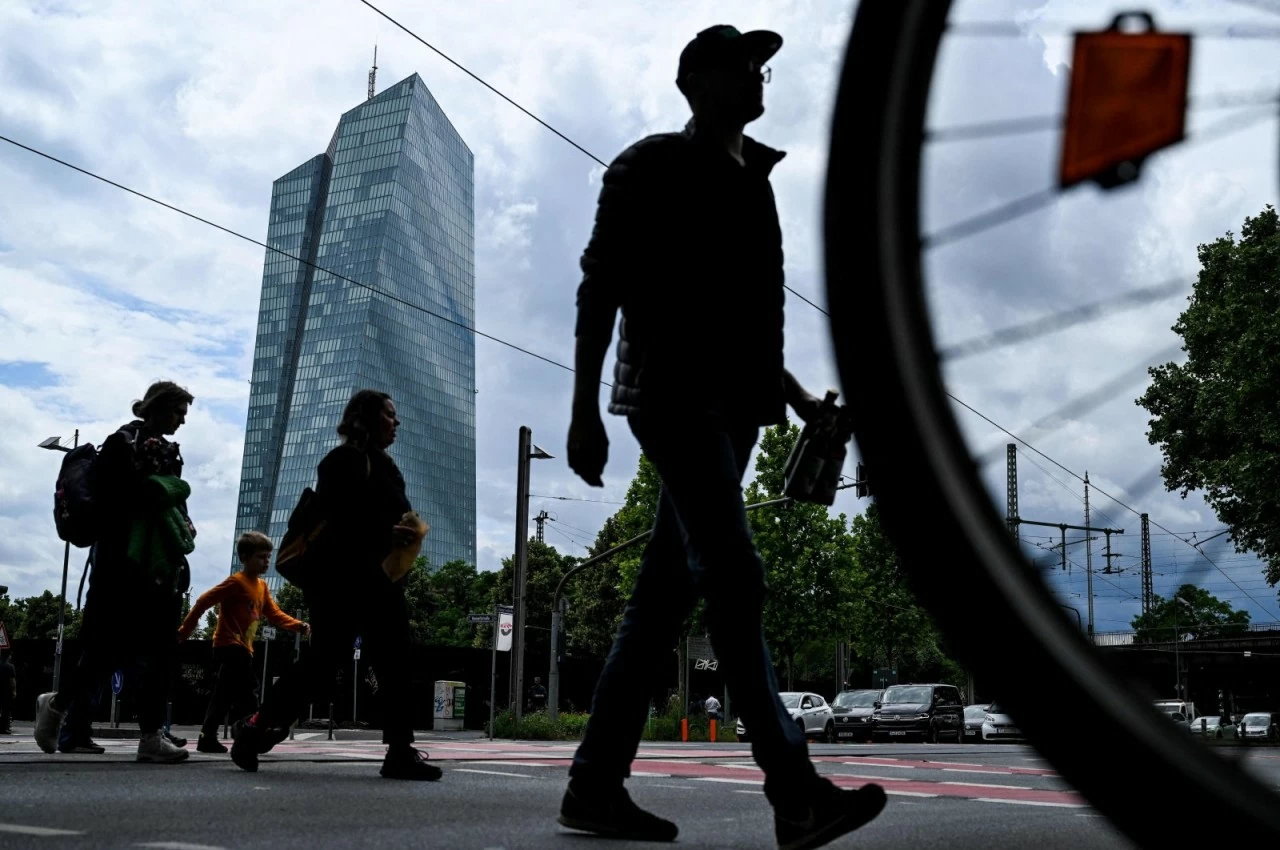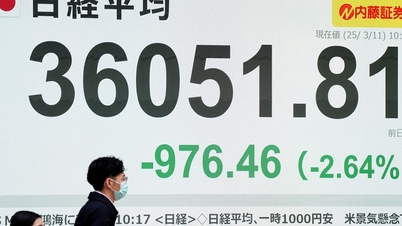Better-than-expected growth in Europe will bring cheer to many. However, concerns remain about Germany, which is weighing on the eurozone.
 |
| Eurozone GDP grew by 0.3% in the second quarter of 2024, exceeding economists ' forecasts. In the photo: People walk past the European Central Bank (ECB) headquarters building in Main, Germany, June 2024. (Source: AFP) |
Europe’s economy grew slightly in the second quarter of 2024 while the US beat expectations, underscoring the persistent transatlantic divide. Germany, the continent’s top economy, continues to struggle as cautious consumers choose to save rather than spend on big-ticket items like homes and cars.
According to official data released by the European Union's statistics agency (Eurostat) on July 30, the gross domestic product (GDP) in the 20 countries using the euro increased by 0.3% in the second quarter of 2024, surpassing economists' forecasts.
The figures are likely to support the European Central Bank’s view that there is no need to rush to lower interest rates further after its June rate cut. Analysts polled by FactSet and Bloomberg had expected European GDP growth to come in at 0.2% in the second quarter.
This achievement follows a 0.3% GDP increase in the first quarter of 2024 - the first significant growth after more than a year of stagnation when only above, equal to or below 0%.
Better-than-expected growth will cheer many, but there are still concerns about Germany, which is weighing on the eurozone.
In addition, there were warning signs for the continent's economy as data last week showed that business activity in the Eurozone slowed in July, with persistent weakness in the manufacturing sector.
The “latecomer” of the region
Data showed Germany unexpectedly slipped back into recession, recording a 0.1% GDP decline in the second quarter of 2024.
"Overall, the statistics once again confirm that Germany is the slowest growing country in the Eurozone," said Carsten Brzeski, an expert at ING Bank based in Amsterdam, the Netherlands.
However, he added that "there could still be a recovery in the second half of this year, although it is unlikely to be a strong recovery."
In contrast, the US economy grew 0.7% in the second quarter of this year compared to the previous quarter, or 2.8% year-on-year.
Consumers in the world’s largest economy are spending more freely. Meanwhile, US government spending and subsidies for business investment in renewable energy, semiconductor manufacturing and infrastructure, under the Deflationary Act, are also contributing to the country’s growth.
In contrast, the situation in Europe is quite different. Consumers are saving at record levels and governments have begun to curb spending to reduce budget deficits.
“The US economy’s outperformance is largely due to strong private consumption and domestic investment,” said Thomas Obst, a senior economist at the Cologne-based German Economic Institute. “Fiscal policy support is higher than in other advanced economies, with total spending accounting for 25% of GDP. Meanwhile, higher interest rates have had less impact on lending and the economy in the US than in Europe.”
France, Spain exceed expectations
In stark contrast to Germany, France - the Eurozone's second-largest economy - and Spain - the fourth-largest, beat growth forecasts in the second quarter of this year, by 0.3% and 0.8% respectively.
The London-based independent economic research organization Capital Economics said that the Summer Olympic Games currently being held in Paris, France, promise to "create a small boost" for the country's economy in the third quarter of this year.
Growth in Spain, one of the region’s strongest performing economies, was driven by strong exports and household spending, while in France, GDP rose on the back of international trade and a recovery in business investment.
Southern Europe appears to be doing better than other countries on the continent, with Italy and Portugal also recording growth of 0.2% and 0.1% respectively.
 |
| Farmers harvest wheat in Stöffin, Germany, on July 21, 2024. The German Association of Agricultural Cooperatives said the country's wheat output in 2024 could fall 5.5% to 20.34 million tonnes from a year earlier. (Source: Bloomberg/Getty) |
Lack of motivation
The latest data also showed that the economy of the 27-nation European Union (EU) grew by 0.3% in the second quarter of 2024.
That follows five straight quarters of essentially flatlining as inflation flared, cutting off consumer purchasing power. Energy prices soared after Russia cut off most of its natural gas supplies in 2022 and as the global economy recovered from the pandemic, straining supplies of parts and raw materials.
Those obstacles have since eased, but Europe faces lingering effects on wage policy, government support for citizens and tax cuts.
Economist Obst noted that while the continent avoided mass layoffs during the pandemic by paying employers to retain workers, the measures have “restricted the ability of the eurozone economy to adapt” and divert resources to new businesses.
“It sounds cliché, but much of the gap in GDP growth stems from higher business dynamism in the US compared to the eurozone,” he said.
Europe’s growth is also being held back by long-term factors such as higher taxes and tighter regulations, which have kept its average annual real GDP growth rate at least one percentage point lower than in the United States, according to Salomon Fiedler, an economist at Berenberg, a Hamburg-based private bank.
“If the Eurozone wants to catch up economically with the US, it needs to raise productivity and increase investment in productive capital,” he said.
In Germany's case, politicians and economists say overly complicated permitting processes, which can take years to get the green light to build a new wind power facility, a lack of skilled workers and lagging investment in infrastructure are among the key issues the country needs to address.
Higher ECB interest rates have helped to lower inflation from 10.6% in October 2022 to 2.5% in June 2024, but have also dampened construction activity and extinguished years of rising house prices. New car sales rose 4.3% in the first half of the year compared to the same period last year but are still about 18% below pre-Covid-19 levels.
Another factor is the unusually high level of precautionary savings among European consumers, which reached 15.4% in the first three months of the year, a record high outside the pandemic years. People are saving more, either because they are looking forward to higher interest rates or because they feel poorer and more fearful about the future, despite low unemployment at 6.4%.
“Savings rates are high and consumer surveys show that ‘intentions to make major purchases are extremely low,’” said Jack Allen-Reynolds, deputy euro zone economist at Capital Economics.
Experts say the data shows the eurozone economy is in better shape than it was a year ago. “After a period of stagnation throughout 2023, this is a relief and shows that the economy has started a cautious recovery,” said Bert Colijn, senior eurozone economist at ING Bank. “The question remains where the economy is headed and recent data do not provide much confidence that the eurozone is accelerating further.”
Source: https://baoquocte.vn/gdp-chau-au-du-tang-truong-vuot-ky-vong-van-duoi-co-my-rat-nhieu-nen-kinh-te-dau-tau-qua-slow-day-chinh-la-ly-do-280843.html


![[Photo] Party and State leaders attend the special art program "You are Ho Chi Minh"](https://vphoto.vietnam.vn/thumb/1200x675/vietnam/resource/IMAGE/2025/5/18/6895913f94fd4c51aa4564ab14c3f250)
![[Photo] Ready for the top competitions of Vietnamese table tennis](https://vphoto.vietnam.vn/thumb/1200x675/vietnam/resource/IMAGE/2025/5/18/9c547c497c5a4ade8f98c8e7d44f5a41)


![[Photo] Many young people patiently lined up under the hot sun to receive a special supplement from Nhan Dan Newspaper.](https://vphoto.vietnam.vn/thumb/1200x675/vietnam/resource/IMAGE/2025/5/18/6f19d322f9364f0ebb6fbfe9377842d3)






























































































Comment (0)